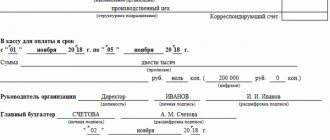Salary in accounting
The accrual and payment of wages, as well as deductions from it, are reflected in account 70 “Settlements with personnel for wages”.
This follows from the chart of accounts approved by order of the Ministry of Finance of Russia dated October 30, 2000 No. 94n. When calculating salaries, the accountant uses the credit of account 70. When paying wages, when withholding personal income tax, alimony and other things, the accountant uses the debit of account 70. Analytics on account 70 must be maintained for each employee of the company.
Insurance premiums should be reflected in account 69 “Calculations for social insurance and security”, and personal income tax - in account 68 “Calculations for taxes and fees” subaccount “Personal Income Tax”.
Fill out and print your balance sheet using the current form for free
Deduction for training from salary upon dismissal in 2021
Enterprises using the general taxation system must contribute compensation to unrealized income if an employee quits early (Article 250 of the Tax Code of the Russian Federation). In this case, income is defined as the amount of compensation as of the actual date the quitter recognized his obligation to pay expenses to the employer. If the obligation to pay compensation is recognized through the court, the date on which the court decision enters into force is indicated.
In March, the LLC sent an employee for training, spending 23,600 rubles. An agreement was drawn up with her, under the terms of which she must work at the enterprise for at least 12 months. The employee completed the course on May 7, and in December she decided to quit by submitting an application. According to the terms of the contract, she is obliged to compensate 7,177 rubles.
Payroll posting dates
The payroll entry for a particular month is dated to the last day of that month.
The date of postings for accrual of advance payment depends on what method of calculation is accepted in the organization. There are two options:
- The advance is equal to wages for the time actually worked in the first half of the month. In this case, as a rule, reserve deductions are made equal to the amount of personal income tax, alimony, etc. The advance accrual posting is created at the end of the first half of the month for which it was accrued (for example, February 14 or September 15). Then they make postings on reserve deductions.
- The advance is equal to a fixed amount, which is calculated as a percentage of the employee’s monthly salary (for example, 40%). With this option, there is no need to create a separate entry for accruing the advance payment. Only the salary accrual entry is made for the entire month, dated the last day of this month (for more details, see: “Salaries for the first half of the month: how to calculate the advance and what amounts to withhold from it”).
Calculate your advance and salary for free, taking into account all current indicators
Postings for accrual and withholding of personal income tax, for writing off reserve withholdings, for calculating insurance premiums and withholding alimony are usually made on the last day of the month for which wages are accrued. And postings for the payment of advance payments and wages, for the transfer of personal income tax and contributions - on the day when the money is debited from the account or issued from the cash register.
How to reflect the deduction of employee training costs from wages in 1C
The LLP, a resident of the Republic of Kazakhstan, is registered for VAT, the generally established taxation regime. In March 2013 A general worker at a warehouse is undergoing training as a slinger. The training company, after completing the training, issues a certificate and NSF in the amount of 7000 tenge, VAT 12%, including 750 tenge. The LLP takes VAT as a credit and assigns 6,250 tenge to expenses of the period. In March 2014 the employee quits and the manager decided to deduct the cost of training 7,000 tenge from the salary and issues an order to deduct when paying the employee. The employee with this deduction agrees as stated in the order. Is it allowed to deduct the cost of employee training from the salary and if “yes”, then what documents are used to do this in 1C accounting version 8.2, what are the accounting entries and what to do with the VAT previously offset and the expenses of the period in 2013?
We recommend reading: What documents should you have for an apartment?
Answer:
Regulations of the Labor Code
Deduction of training costs from an employee’s salary is possible in accordance with the Labor Code and a training agreement concluded between the employee and the employer. Deductions from the employee’s salary are made in accordance with Art. 137 of the Labor Code of the Republic of Kazakhstan with the written consent of the employee. In the configuration "1C: Accounting 8 for Kazakhstan" employee retention.
Types of postings for salaries and taxes
Payroll
In accounting, personnel wages are expenses for ordinary activities (PBU 10/99 “Organizational Expenses”).
Manufacturing companies reflect wages in the debit of accounts: 20 “Main production”, 23 “Auxiliary production”, 26 “General business expenses”, 29 “Service production and facilities”. Trading companies - in the debit of account 44 “Sales expenses”.
When calculating salaries, the following entries are made:
DEBIT 20 (23, 26, 29, 44) CREDIT 70 - the salary of such and such employee has been accrued
REFERENCE. When calculating an advance calculated as salary for the first half of the month, you need to make the same entries as when calculating salaries at the end of the month.
Reserve deductions from wages for the first half of the month
Organizations in which the advance is equal to the salary for the time actually worked in the first half of the month often make reserve deductions in an amount equal to the amount of personal income tax, alimony, etc. They are shown in the debit of account 70 and the credit of account 76 “Settlements with various debtors and creditors” for the corresponding subaccount.
When making backup deductions, the following postings are made:
DEBIT 70 CREDIT 76 subaccount “Reserve deductions for personal income tax” - reserve deduction of personal income tax from the salary of such and such employee
DEBIT 70 CREDIT 76 subaccount “Reserve deductions for alimony” - reserve deduction of alimony from the salary of such and such an employee
Deductions from wages: personal income tax, alimony, etc.
When withholding personal income tax, the following entries are made:
DEBIT 70 CREDIT 68 subaccount “NDFL” - personal income tax is withheld from the salary of such and such employee
When alimony is withheld, the following entries are made:
DEBIT 70 CREDIT 76 subaccount “Alimony payments” - alimony is withheld from the salary of such and such an employee
For other deductions, use the credit of the account appropriate for the specific situation.
If the advance is equal to the salary for the time actually worked in the first half of the month, and reserve deductions were made, then at the end of the month they must be written off.
When writing off reserve deductions, the following entries are made:
DEBIT 76 subaccount “Reserve deductions for personal income tax” CREDIT 70 - reserve deductions for personal income tax of such and such employee are written off
DEBIT 76 subaccount “Reserve deductions for alimony” CREDIT 70 - reserve deductions for alimony of such and such employee are written off
Calculation of insurance premiums
Like wages, insurance premiums in accounting are classified as expenses for ordinary activities. The accrual of contributions is reflected in the debit of accounts 20 (23, 26, 29, 44) and the credit of account 69 in the corresponding subaccount (subaccounts are opened by type of insurance).
IMPORTANT. In the posting for calculating insurance premiums, account 70 is not involved. This is because contributions are not included in wages and are not deducted from it.
When calculating contributions, the following entries are made:
DEBIT 20 (23, 26, 29, 44) CREDIT 69 (sub-account by type of insurance) - insurance premiums have been accrued.
Payment of advance and salary
The advance payment, as well as the accrued salary minus personal income tax, alimony and other deductions, is given to the employee. If an employee receives money at the cash desk, a credit entry is made to account 50 “Cashier”. If money is transferred from an organization’s current account to an employee’s card, a credit entry is made to account 51 “Current accounts”.
When paying an advance and salary, the following entries are made:
DEBIT 70 CREDIT 50 - an advance (salary) was issued from the cash register;
DEBIT 70 CREDIT 51 - advance payment (salary) is transferred from the current account.
Transfer of personal income tax and contributions
The organization must transfer personal income tax to the budget no later than the day following the day the salary is paid (clause 6 of Article 226 of the Tax Code of the Russian Federation). Insurance premiums for a particular month should be transferred no later than the 15th day of the next month (clause 3 of article 431 of the Tax Code of the Russian Federation; part 4 of article 22 of the Federal Law of July 24, 1998 No. 125-FZ).
When transferring personal income tax and contributions, the following entries are made:
DEBIT 68 (69 corresponding subaccount) CREDIT 51 - personal income tax (insurance contributions) is transferred
Calculate your salary, contributions and personal income tax for free in the web service
Deduction for training from an employee's salary upon dismissal
Please tell me how to reflect the deduction for training from an employee’s salary upon dismissal in an autonomous preschool educational institution? In December 2014, cooks were trained to confirm or increase their rank. Payment for tuition was made under an agreement with the educational institution from a subsidy for a municipal task. An additional agreement was concluded with the employee’s employment contract stating that the employee, after training, undertakes to work for 2 years. If dismissed early, the employee must reimburse part of the cost of training. Upon dismissal, at the request of this employee, part of the cost of training was withheld in accordance with Article 211 and restored to the personal account with the financial authority in accordance with Article 226 with one payment order. As this business. is the transaction reflected in form 0503737 (as cash or non-cash transactions)?
we inform you the following
: Deduction from an employee’s salary upon dismissal, reflect the institution’s expenses for his training in accounting similarly to the material given, reflecting the employee’s debt in account 2.205.30.000 as compensation for the institution’s expenses under subarticle KOSGU 130 “Income from the provision of paid services (work)”, and not as the restoration of cash expenses under subarticle KOSGU 226 “Other work, services.” Reflect the accrued debt of the employee to reimburse the training paid for by the institution by posting: Debit 2.205.30.000 Credit 2.401.10.130. Reflect the deduction from the employee's salary in accounting using one of the options given. In the financial statements, the deduction from an employee’s salary of the institution’s expenses for his training will be reflected as a non-cash transaction only if the institution selects the correspondence accounts considered in option 1.
Dismissal of an employee: we withhold money for training
In the first case, reimbursement of expenses is made in the manner prescribed in the contract. In the second case, compensation of funds is made in accordance with the general procedure for compensation of material damage by the employee, namely (Chapter 39, Article 137-138 of the Labor Code of the Russian Federation, determination of the Constitutional Court of the Russian Federation dated July 15, 2010 No. 1005-O-O):
If an employee leaves the organization who has not completed the period established by the apprenticeship contract and does not have a valid reason for dismissal, then he must reimburse the employer for the costs associated with his training (for more information, see “Termination of the apprenticeship agreement for valid reasons”). Training costs must be compensated in an amount proportional to the time not worked by the employee (for more information, see “We compensate for the costs incurred on training an employee upon his dismissal”). Depending on how the student agreement is drawn up, two options for reimbursement of expenses are possible:
Deduction from an employee's salary for wiring training
Deductions from wages when serving correctional labor, collecting alimony for minor children, compensation for harm caused to the health of another person, compensation for harm to persons who suffered damage due to the death of a breadwinner, and compensation for damage caused by a crime can amount to up to 70% of wages.
3. Refund of amounts overpaid to the employee due to accounting errors, as well as amounts overpaid to the employee, if the body for consideration of individual labor disputes (commission on labor disputes, court) recognizes the employee’s guilt in failure to comply with labor standards (155 Labor Code of the Russian Federation) or simple (Part 3 of Article 157 of the Labor Code of the Russian Federation).
How to return the costs of training an employee upon his dismissal: procedure and amount of deductions
The document also specifies other conditions agreed upon by the parties. This may be the provision of any guarantees, the procedure for paying for training, or the obligation of the entrepreneur to provide a job after completion of training.
Drawing up a student agreement and following this document are the most important points in the activities of each organization. If the manager has to withhold compensation for employee training expenses, it is necessary to draw up an appropriate agreement.
The procedure for deducting shortfalls from wages, examples of postings and errors
In itself, such an order cannot be legal, because it does not comply with labor legislation. In a situation where errors in documents lead to material damage to the company, for example, errors in a tax return can lead to a fine issued to the organization, even in this case a special commission must be organized to identify the perpetrators and obtain explanatory notes from them. And only then is an order issued to recover damages from these specific individuals in a specific case.
An employee of a car rental company received a fine for improperly parking a company car while using it after hours. The fine was issued to the organization and amounted to 5,000.00 rubles. The average monthly salary of an employee is 27,000.00 rubles. Based on the fact of the damage incurred, the company drew up relevant acts, which the culprit was familiarized with.
Deduction for wiring training
Debit 73 Credit - reflects the employee’s debt to reimburse the organization’s expenses for his training. Debit 50 Credit 73 - the amount of debt for reimbursement of training expenses for the remaining amount has been entered into the cash register. Compensation for training expenses received upon early dismissal of an employee is included in non-operating income. The rationale for this position is given below in the materials of the Glavbukh System. Recommendation: How to reflect in accounting and taxation the compensation received from an employee to reimburse the costs of his training. Regardless of whose interests the employee is studying, the organization has the right to determine the conditions under which it will pay the costs associated with his training. Typically, these conditions boil down to the fact that after training the employee must work in the organization for a certain period of time.
In the first case, the organization compensates the employee for the cost of training. In the second case, the organization itself will conclude an agreement for the provision of educational services to the employee and pay their cost. In such a situation, the manager issues an order to pay for the employee’s education at the expense of the organization’s own funds. Such documents, for example, could be:. If the organization pays for the employee’s studies directly to the educational institution, reflect this with the following entries:.







